On May 7, HU Miao, born in 1980s, a doctor of Shanghai East Hospital of Tongji University dispatched to the Antarctic Great Wall Station of China, returned home after 540 days of service at the station, a record in the history of the China Antarctic Scientific Expedition Team, due to the impact of the COVID-19 pandemic.
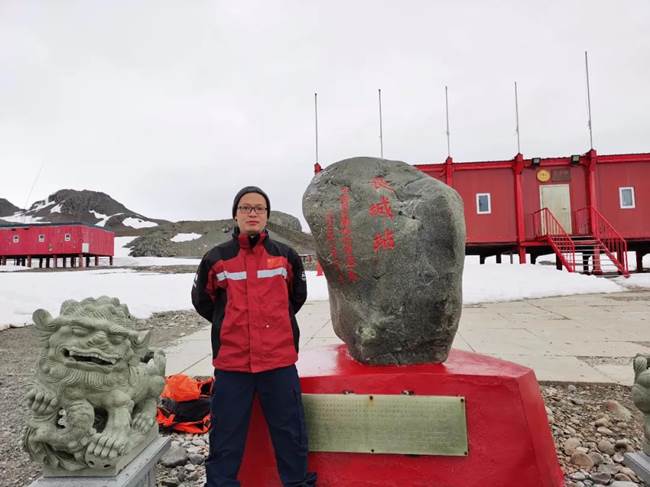
HU Miao in front of the Great Wall Station
Apart from the well-known record, Dr. HU Miao had completed his top mission of epidemic prevention and control and guaranteed the vegetable supply in a totally isolated environment for half a year. How did he fulfil his duties as a doctor under the extreme situations in the Antarctic region, such as 3-day-long storm and an earthquake? What joys and sorrows had he experienced? What a strong mentality is this to tackle all the unexpected circumstances in such a desolate, harsh wilderness?
Here are HU Miao’s notes about the life at South Polar.
As a member of the China Antarctic Scientific Expedition Team, I had been staying at the Great Wall Station for 18 months, or 540 days, which could be divided into a few stages as follows.
Stage 1: from December 6, 2019 (arrival of the team at the Great Wall Station) to February 12, 2020 (retreat of all summer members by the Xuelong 2 icebreaker, with 14 winter members staying)
My first challenge was to learn to grow vegetables while ensuring the medical service. It is well known that, without the vegetable intake for an extended period of time, the body will have illnesses including scorbutus due to the lack of Vitamin C. After a period of learning, I was so delighted to see the cabbage, cucumber and tomato flourishing and blossoming, thanks to the Antarctic vegetable greenhouse developed by Tongji University that really helped guarantee our health.
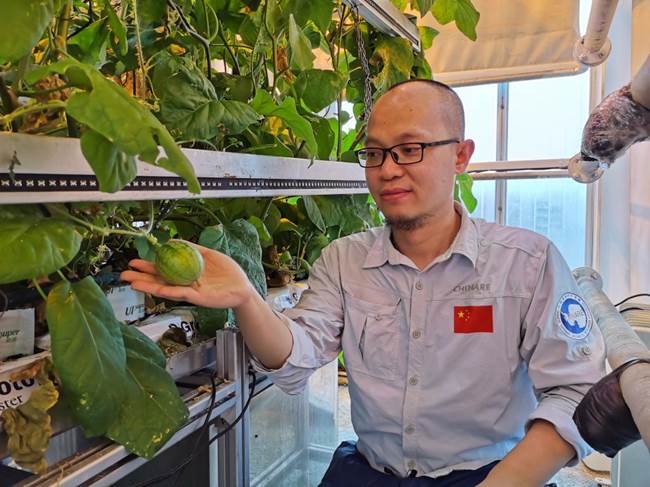
HU Miao and his water melon
It was then when the COVID-19 started to spread across the world and we, upon approval, decided to lock down the Great Wall Station with no exchange of personnel and materials with the outside world. Before the lockdown, I was a skilled worker capable of painting, handling steel pipes and fertilizer, fixing lighting tubes, driving trolley, fitting shelf, flooring, etc. and an experienced farmer good at attending the vegetables.
In the Antarctic region, the vegetables were a treasure, and everyone felt glad to have the vegetables supplied regularly. However, with so many people at the station, it’s impossible to serve a generous dish of vegetables. Instead, a soup with a few slices of tomato and some green leaves would make everyone happy.
Stage 2: from February 13, 2020 to October 31, 2020 - the winter period for the Antarctic Scientific Expedition Team No. 36, with only 14 members staying to ensure the normal operation of the station under the lockdown and self-sufficiency
With the retreat of summer members, the station turned from a bustling village into a silent place. This winter, the station was not able to source fresh vegetables and fruits from Argentina as it had done before, since the pandemic completely disconnected us from the outside world. The stored vegetables and fruits were finished soon while the frozen meats and grains remained sufficient, but there is a severe lack of vitamins and celluloses in our diet. As a doctor, I felt stressed, because I was clearly aware of the consequence of a lack of Vitamin C and celluloses in body for an extended period of time and the impact of scorbutus on human’s maritime history (a nightmare for European voyages before the 18th century).
I must increase the vegetable output! Asking help from an agricultural professional in Shanghai, searching for agricultural information, and studying the vegetable varieties and management technology, I just had one goal in mind - to get the most out of the little greenhouse. I employed cross cultivation, parallel management, alternating planting and other measures to overcome such harsh elements as strong UV, low temperature, wild wind, high temperature difference between day and night in summer and prolonged winter nights. All my efforts paid off, as the greenhouse surprisingly produced an average of 1kg vegetables per day. I, as a doctor, was totally a green hand in growing vegetables. Despite all the hardships I went through, I was proud of satisfying the essential nutritional needs of the team of 14 with the 1kg of vegetables each day. We had stood up to the situation in the Antarctic region where there was no access to foreign aids and assistances.
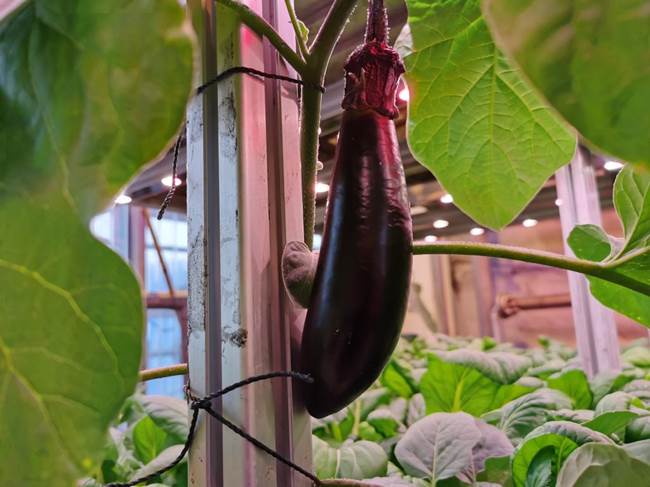
HU Miao and his eggplant
The hurricane in the winter at the South Polar is something that you experienced once and wish you would never do it again. Everything on the ground seemed to be blown into the air, as the gale howled, smashed and shattered. We were scared at the beginning and gradually got used to it day by day. The gale, occurring every 2 or 3 days, swept the earth with snows and hails, and blurred the horizon in a dark shade. The most severe blizzard lasted three days and nights, trapping us (including the chef) in the dormitory without the possibility to access the dining room. We had to eat fast noodles and sausages for 3 days in a raw. We were very clear that life safety is of the upmost importance.
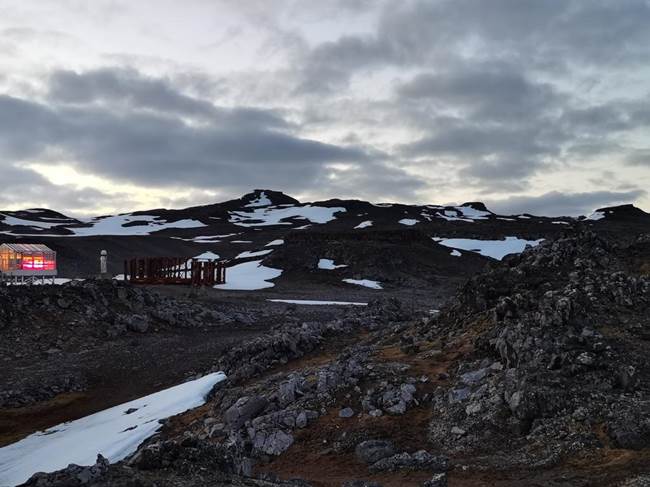
The South Polar in winter
Anything might happen at the South Polar in winter. Every one of us needed to stay alert as if we were at war, so that the station operations could be maintained with air conditioner and electric appliances working normally under a continuous temperature of -18 ℃.
Yet the COVID-19 was something that worried me the most. As a doctor, I understood that, as the virus kept spreading and mutating, most of the research stations in the Antarctic region were locked down, and we would face a grim situation if any one of us was seriously ill, given the fact that only simple medical equipment was available at the station. The five research stations nearby might deny our request of help for the sake of epidemic prevention. So, we must protect ourselves well. “Always take protective measures in field works; avoid a fiercely competitive sport; keep a balanced diet...” I told my co-workers almost everyday. I bet it was pretty annoying when I was repeating those words. However, it was my duty to do so for the sake of everyone’s safety.
Many thanks to everyone there! We had survived the conditions for 540 days and were all safe and sound without serious illness. I couldn’t help weeping when boarding the Xuelong 2. I told myself, “You are the lucky one!”
Stage 3: From November 11, 2020 to February 28, 2021 - the summer period for the Antarctic Scientific Expedition Team No. 37
As the COVID-19 continued to spread worldwide, in order to guarantee the safety, the Team No. 36 had to stay at the Great Wall Station before returning home with Xuelong 2. As a result, most of the team members were not able to return (by air or other public transportation means via multiple countries) at the end of 2020 as planned, and some had to said a prayer or made a wish for their new-born baby or ill or deceased family member 17,000 kilometers apart. One must obey the order of his/her country, just as the soldiers who must fight upon the command of the country.
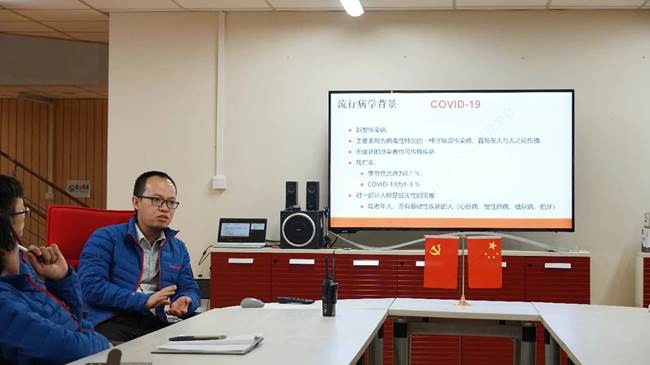
HU Miao briefing on the background of epidemiology
The outbreak of the virus finally occurred in the Antarctic region at the end of 2020. Lots of COVID-19 cases were confirmed at several military research stations of Chile, with its navy station being only a few kilometers away from the Great Wall Station. Of course, we were worried. But worry was not enough. We must take scientific actions, learning from the successful experience of China as well as the lessons of some countries failing to contain the virus. Upon the instructions of the Ministry of Natural Resources and the Hospital, we raised the alert level and stayed on guard. Signs in Spanish and English were put at both the exit and entrance of the station; all team members were prohibited from touching wild animals (mainly birds and fishes); and everyone were subject to two temperature tests per day and required to report discomforts if any. Thanks to every team member for the joint efforts, we thoroughly cut off the channels of transmission such as respiratory tract, digestive tract and close contact. Our prevention and control measures were proven to be reliable and effective, ensuring our safety and normal operations amidst the epidemic that was raging across the Antarctic Peninsula.
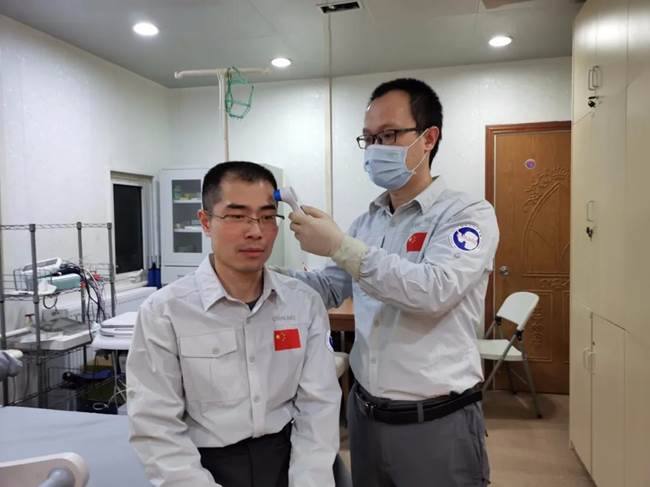
A team member taking his temperature
While the epidemic continued, an earthquake, measuring 7.0 in magnitude, jolted the South Shetland Islands where the Great Wall Station is located on January 23, 2021, 07:36 pm. We took a series of actions in accordance with the contingency plan. As soon as the tsunami warning was cancelled a few hours later, we carried out a patrol inspection throughout the station and felt relieved after confirming there were no damage incurred.
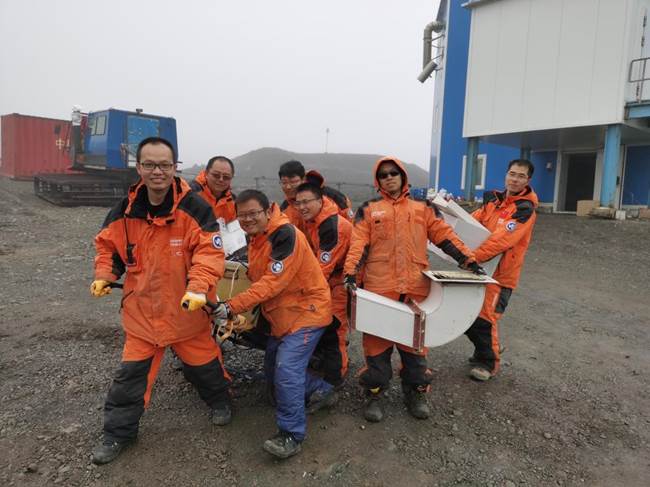
Team members posing for a group photo
Our vegetable seeds were almost finished at the end of the 37th summer since the establishment of the station. As the impact of pandemic continued and deepened, the station was in a growing shortage of foods, while fresh fruits became a memory and dream. The little greenhouse was the only source of the fresh vegetable supply each day. I attended the greenhouse more carefully then, fabricating nutrient solutions and regulating the lighting, temperature, ventilation, humidity and artificial lighting via computer programs, with an effort to help the vegetables grow faster. Later, some seeds of vegetables, e.g. napa cabbage and Chinese cabbage, were finished.
The chef must be applauded for managing to create and refine on the foods and cuisines and satisfying our appetites with joy and delight amidst all the hardships. We were all aware that we should keep the original aspiration and confidence and stay at our posts until the Xuelong 2 icebreaker comes.
The Korean ship took their team home on February 4 this year, which was really admired by us. Standing on the shore and I could not take my eyes off the colorful ship at that moment - their ship has come, and Xuelong 2 will not be far behind!
Stage 4: from March 1, 2021 to March 12, 2021 - the arrival of Xuelong 2 and work handover to Team No. 37
It was my second winter at the South Polar. Penguins and seals had migrated to the lower latitudes, leaving the expedition teams and a few birds amidst the wind and snow. It became colder with shorter daytime. The sun had risen no sooner than it set, providing less sunlight. However, I was happy in awareness of the fact that Xuelong 2 was on its way. We were then busy preparing for the work handover everyday.
March 6 was a big day when the long-anticipated Xuelong 2 icebreaker arrived at the Great Wall Station and brought the first fellow countrymen that we have met since over one year ago. We also had the longing taste of Chinese cabbage, green cabbage, apple, etc. They were so sweet!
A handover ceremony was held on March 12, signifying the complete work handover between the Teams No. 36 and No. 37. My mission at the Great Wall Station was complete too. I embarked on return trip with the ship.
Conclusion
Tears rolled down my cheeks the moment I stepped on the land of my mother country again on May 7. Even tears tasted sweet when a man returned home after over 500 days of working abroad.
A multitude of feelings surged up. It is a little disappointing that we didn’t have the chance to exchange with foreign research stations due to the pandemic, but I’m so proud of having completed the mission at the South Polar. Our efforts and defense have kept the Great Wall Station safe despite the pandemic worldwide and the serious infection at the nearby foreign stations. As a doctor, I have ensured that all the team members return home in good health without serious injury and illness over the past over one year. As a doctor, I also have taken care of the greenhouse that set a record in terms of vegetable production at the Great Wall Station - 323.2 kg of leaf vegetables and 117 kg of fruit vegetables (440 kg in total).
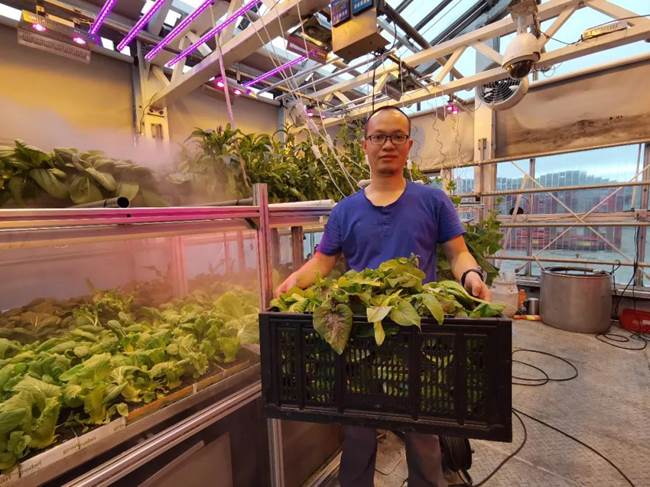
HU Miao and the harvest of vegetables
At last, I’d like to say that every one of the team is a hero!
HU Miao said, “I had submitted my application for joining the CPC before departing. I take pride in having stood up to the test in the scientific expedition. I will continue to work hard afterwards.”
Text edited by CHENG Guozheng
https://news.tongji.edu.cn/info/1003/77517.htm